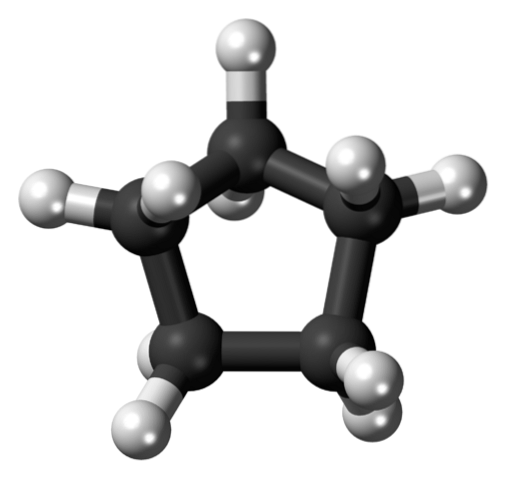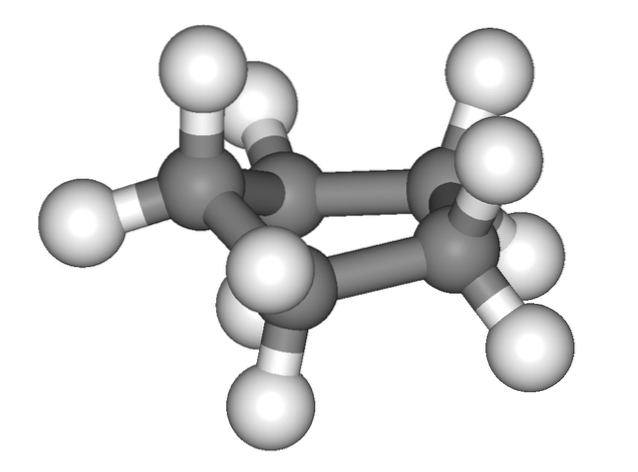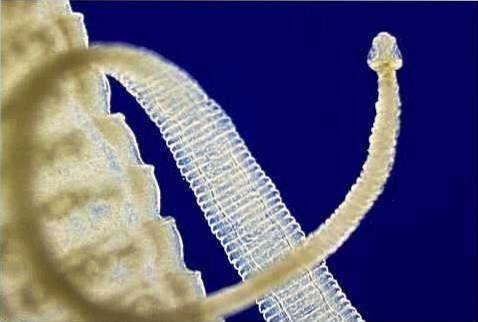
Cyclopentane (C5H10) structure, properties and uses
The cyclopentane it is a cyclic hydrocarbon, specifically a cycloalkane. In turn, it is an organic compound whose molecular formula is C5H10. It can be viewed as the closed version of the n-pentane, open chain, in which its ends have been joined by the loss of two hydrogen atoms.
The lower image shows the skeleton of cyclopentane. Notice how geometric its skeleton looks, forming a pentagonal ring. However, its molecular structure is not flat, but rather presents folds that seek to stabilize and reduce the stress within the ring. Cyclopentane is a highly volatile and flammable liquid, but not as flammable as n-pentane.

Due to its solvent capacity, cyclopentane is one of the most widely used solvents in the chemical industries. It is not surprising that many products with strong odors contain it among their composition, being therefore flammable. It is also used as a blowing agent for polyurethane foams used in refrigerators..
Article index
- 1 Structure of cyclipentane
- 1.1 Intermolecular interactions
- 1.2 Conformations and ring stress
- 2 Properties of cyclipentane
- 2.1 Physical appearance
- 2.2 Molar mass
- 2.3 Melting point
- 2.4 Boiling point
- 2.5 Flash point
- 2.6 Autoignition temperature
- 2.7 Heat of vaporization
- 2.8 Viscosity
- 2.9 Refractive index
- 2.10 Vapor pressure
- 2.11 Density
- 2.12 Solubility
- 2.13 Octanol / water partition coefficient
- 2.14 Reactivity
- 3 Uses
- 3.1 Industrial solvent
- 3.2 Ethylene source
- 3.3 Insulating polyurethane foams
- 4 References
Structure of cyclipentane
Intermolecular interactions

The first image showed the cyclopentane skeleton. Above now we see that it is more than a simple pentagon: hydrogen atoms (white spheres) protrude on its edges, while carbon atoms make up the pentagonal ring (black spheres).
By having only C-C and C-H bonds, their dipole moment is negligible, so cyclopentane molecules cannot interact with each other through dipole-dipole forces. Instead, they are held together thanks to London's dispersive forces, with the rings attempting to stack on top of each other..
This stacking offers some contact area greater than that available between linear molecules of n-pentane. As a result of this, cyclopentane has a higher boiling point than n-pentane, as well as a lower vapor pressure.
Dispersive forces are responsible for cyclopentane forming a molecular crystal when frozen at -94 ºC. Although there is not much information regarding its crystalline structure, it is polymorphic and has three phases: I, II and III, with phase II being a disorderly mixture of I and III..
Conformations and ring stress

The image above gives the false impression that cyclopentane is flat; but it's not like that. All its carbon atoms have sp hybridization3, so their orbitals are not in the same plane. Also, as if this were not enough, the hydrogen atoms are very close to each other, strongly repelled when they are eclipsed..
Thus, we speak of conformations, one of them being the half chair (top image). From this perspective, it is clearly seen that the cyclopentane ring has bends, which help to reduce its ring tension due to its carbon atoms so close to each other..
This tension is due to the fact that the C-C bonds present angles smaller than 109.5º, the ideal value for the tetrahedral environment as a result of their sp hybridizations3.
However, despite this stress, cyclopentane is a more stable and less flammable compound than pentane. This can be verified by comparing their safety diamonds, in which the flammability of cyclopentane is 3, while that of pentane, 4.
Properties of cyclipentane
Physical appearance
Colorless liquid with a mild petroleum-like odor.
Molar mass
70.1 g / mol
Melting point
-93.9 ºC
Boiling point
49.2 ºC
Flash point
-37.2 ºC
Autoignition temperature
361 ºC
Heat of vaporization
28.52 kJ / mol at 25 ºC
Viscosity
0.413 mPa s
Refractive index
1,4065
Vapor pressure
45 kPa at 20 ° C. This pressure corresponds to about 440 atm, however lower than that of the n-Pentane: 57.90 kPa.
Here the effect of the structure is manifested: the cyclopentane ring allows more effective intermolecular interactions, which binds and retains its molecules more within the liquid compared to the linear molecules of the n-pentane. Therefore, the latter has a higher vapor pressure.
Density
0.751 g / cm3 at 20 ° C. On the other hand, its vapors are 2.42 times more dense than air.
Solubility
In one liter of water at 25ºC, only 156 mg of cyclopentane dissolves, due to its hydrophobic nature. However, it is miscible in nonpolar solvents such as other paraffins, ethers, benzene, carbon tetrachloride, acetone, and ethanol..
Octanol / water partition coefficient
3
Reactivity
Cyclopentane is stable when stored properly. It is not a reactive substance because its C-H and C-C bonds are not easy to break, even though it would lead to the release of energy caused by the tension of the ring.
In the presence of oxygen, it will burn in a combustion reaction, be it complete or incomplete. As cyclopentane is a very volatile compound, it must be stored in places where it cannot be exposed to any heat source..
Meanwhile, in the absence of oxygen, cyclopentane will undergo a pyrolysis reaction, decomposing into smaller and unsaturated molecules. One of them is 1-pentene, which shows that heat breaks the cyclopentane ring to produce an alkene.
On the other hand, cyclopentane can react with bromine under ultraviolet radiation. In this way, one of its C-H bonds is replaced by C-Br, which in turn can be replaced by other groups; and thus, cyclopentane derivatives are emerging.
Applications
Industrial solvent
The hydrophobic and apolar character of cyclopentane makes it a degreasing solvent, along with other paraffinic solvents. Because of this, it is usually part of the formulations of many products, such as glues, synthetic resins, paints, adhesives, tobacco and gasoline..
Ethylene source
When cyclopentane is subjected to pyrolysis, one of the most important substances it generates is ethylene, which has countless applications in the world of polymers..
Insulating polyurethane foams
One of the most notable uses of cyclopentane is as a blowing agent for the manufacture of insulating polyurethane foams; that is, cyclopentane vapors, due to their high pressure, expand the polymeric material until it forms a foam with beneficial properties to be used in the frame of refrigerators or freezers.
Some companies have chosen to substitute HFCs for cyclopentane in the manufacture of insulating materials, since it does not contribute to the deterioration of the ozone layer, and also reduces the release of greenhouse gas into the environment.
References
- Graham Solomons T.W., Craig B. Fryhle. (2011). Organic chemistry. (10th edition.). Wiley plus.
- Carey F. (2008). Organic chemistry. (Sixth edition). Mc Graw Hill.
- Wikipedia. (2020). Cyclopentane. Recovered from: en.wikipedia.org
- National Center for Biotechnology Information. (2020). Cyclopentane. PubChem Database, CID = 9253. Recovered from: pubchem.ncbi.nlm.nih.gov
- Elsevier B.V. (2020). Cyclopentane. ScienceDirect. Recovered from: sciencedirect.com
- GE Appliances. (January 11, 2011). Reducing greenhouse gas emissions at GE's refrigerator manufacturing facilities. Recovered from: pressroom.geappliances.com



Yet No Comments